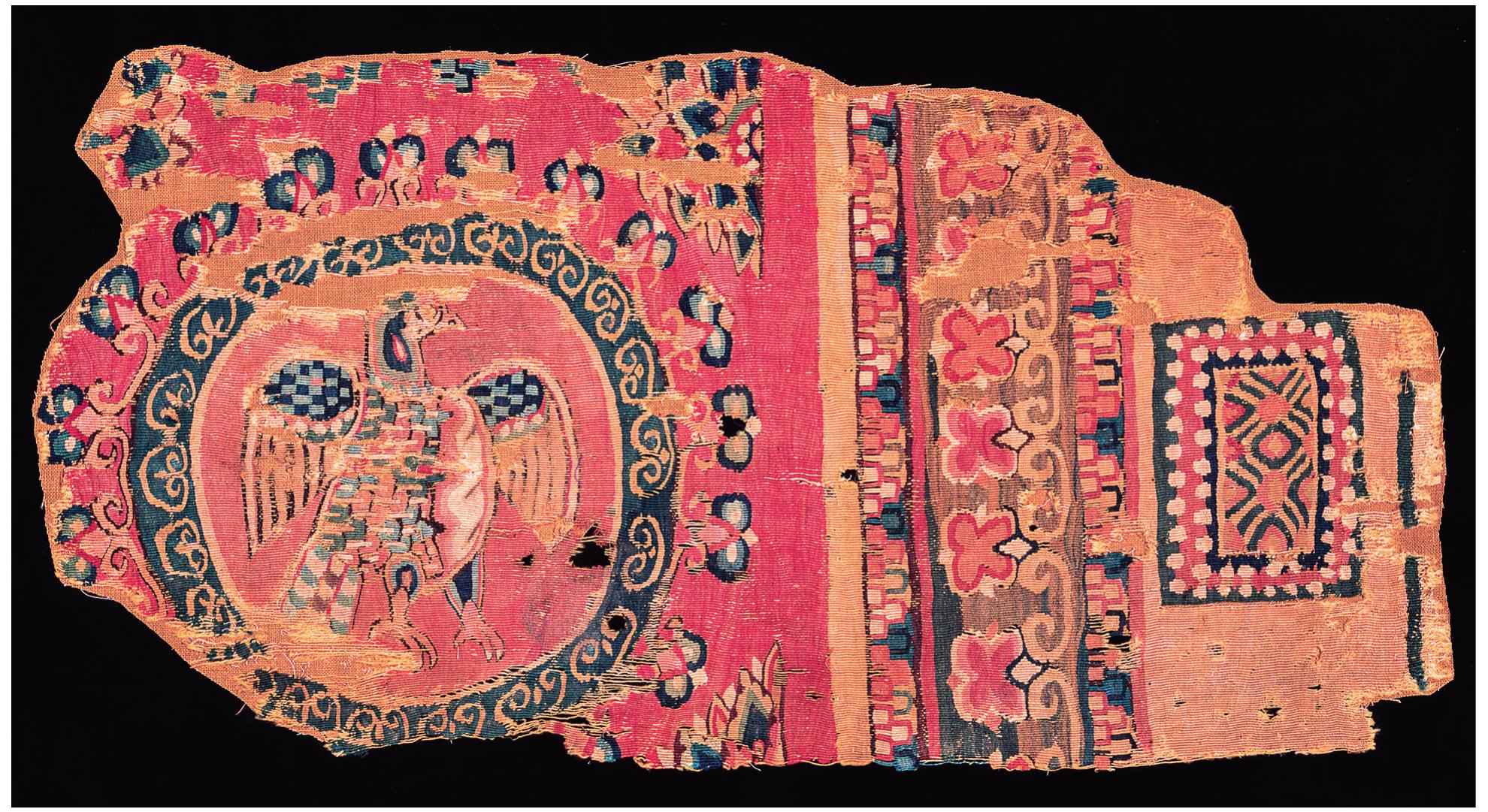Anadolu coğrafyasında çapraz işleme tekniği olarak bilinen kanaviçe, geleneksel tekstil işleme yöntemlerinden biridir. Kanaviçe diğer geleneksel tekstil işleme yöntemleriyle karşılaştırıldığında uygulama açısından daha pratiktir. Bu... more
Over de 17e en 18e eeuwse tabakspijpenbakkers die in Haarlem werkzaam waren is maar weinig bekend. Hierbij een eerste aanzet uit 2001, gegevens over deze groep worden nog altijd verzameld.
Long regarded as a quintessentially Islamic invention-mihrab, an architectural feature also used in textiles that designates the direction of Mecca-it appears, under closer scholarly scrutiny, not as a novel creation but as the... more
Hereke rugs are among the most coveted of collectibles: beautiful, costly, and-like all objects of great aesthetic value-frequently imitated. The town of Hereke, not far from Istanbul, became synonymous with luxury weaving when Sultan... more
Ferda Tazeoğlu Filiz, 2009’da Anadolu Üniversitesi Güzel Sanatlar Fakültesi Cam Bölümü’nde lisans eğitimini tamamlamıştır. 2016’da Anadolu Üniversitesi Güzel Sanatlar Enstitüsü Seramik Anasanat Dalı’ndan “21. yy.’da seramik ve cam... more
This richly illustrated handbook offers clear English explanations and practical tips for students and collectors interested in authentic Persian handmade carpets.
A series of scientific methods (X-ray analyses, optical and electron microscopy, Raman spectroscopy and thermal analyses) was used to research the ceramic bodies and glazes of forty vessels from Renaissance Prague. The set of Early Modern... more
The Catalog of my exhibition in NYC at the Turkish house. Azerbaijani Carpet Splendor Safavid Treasures in Antique Weaving
Geleneksel Türk Sanatları alanının, hammadde, coğrafya, tarih fark etmeksizin Türklerin ürettiği somut ve soyut kültürel miras ile ilgili olduğu bilinmektedir. Bu çalışmanın amacı, Anadolu’dan başka bir coğrafyada yaşamış Türk... more
Cloth and bagseals excavated in the city of Amsterdam from a private collection.
This study examines Mycenaean and tile art from a comparative perspective, exploring the cultural, aesthetic, and functional features of both artistic forms. While Mycenaean art holds a significant place in the Late Bronze Age Aegean with... more
This project seeks to examine the romantic, picturesque, and oriental images that appeared in illustrated magazines, newspapers, and travelers’ accounts in the United States, France, and Greece in the 20th century. My project aims to... more
The Melan Tekke in Nepravishta, Libohova, dates back to the 19th century and represents an important monument of cultural and religious heritage in the Gjirokastër region. As a spiritual and social centre for the Bektashi community, the... more
The Fatimid, who had often considered themselves to be completely descendants of the Prophet, became prominent, and they made a claim to the prophet's succession. Within this, by leading this political and religious sense of mission, they... more
The Martin Brothers are a family that lived in England in the 19th century and are known for their original grotesque ceramic works and a business known by their names. The lives of the Martin Brothers, the functioning of their studio,... more
Thessaloniki was the biggest city conquered by the Ottomans before Istanbul. Furthermore, it was conquered by force. Thus, this city is a good example for researchers to understand how the Ottoman state transformed a Byzantine metropolis... more
Patterns in nature result from dynamic relationships of forces and constraints. What is analogous for patterns in art? Art is created by human hands motivated by inspiration and thought. It is the product of creativity and skill.... more
READING THE EPIC MASTERPIECE SHAHNAMEH THROUGH TILES AND CERAMICS The epic poem Shahnameh, written in the Masnavi style by the epic poet Ferdowsi, is considered Iran's national epic and a masterpiece of Persian literature. Ferdowsi... more
This dissertation focuses on Palia Sagiada, a little-known deserted settlement in Thesprotia, coastal Epirus-Greece, aiming to reconstruct tangible and intangible aspects of a bygone culture on the contested border between Greece and... more
s "Broken Ladies" Porcelain Trinket Series Evaluation in the Context of Kitsch ÖZ Porselen (porcellana) kelimesi ilk olarak Marco Polo tarafından deniz kabuklarını ifade etmek için kullanılmıştır. Çin'de üretilmiş olan porselen kapları... more
The goal of this study is to investigate the connective role of Art Education between Traditional Aegean Architecture and Cultural Heritage. For this purpose 160 students of the Department of Primary Education, University of the Aegean,... more
Increasing the surface quality of porcelain tiles, preferred in public, commercial, and living centers, where human density is high, is one of the crucial goals. Surface applications can be applied on the tiles produced as glazed and... more
This research paper explores Iznik ceramics, with a particular focus on a plate located at the Ariana Museum in Geneva. It examines both the manufacturing techniques and the historical significance of these pieces.
The breech-loading rail guns appeared in Europe in the 15th century, and in the next century they were widely used as light naval artillery. They were characterized by a high rate of fire, thanks to the use of... more
Mukarnas formunun gelişimi
Clothing, which is one of the most basic needs of human beings, has developed every period since the existence of humanity and has continued to the present day. In the study, the medieval period of clothing-textiles and the developments... more
TEKFUR SARAYI GEREK KONUMU GEREK ÇÖZÜMLEMESİ GÜÇ MİMARİSİYLE DIŞARIDAN KENDİSİNİ SEYREDENLERDE HER DÖNEM BİR MERAK OLUŞTURUR. ŞİMDİLERDE MÜZE OLARAK ZİYARET EDEBİLDİĞİMİZ BU YAPI, ZAMANINDA METRUK VE DÖRT DUVARDAN İBARETTİ. ANCAK TARİH... more
Antonis ve Alexandros Benaki kardeşler tarafından oluşturulan koleksiyonu anlatan eser, 320 sayfadan oluşmaktadır. Kitap, 112 seramik, 59 çini levha ile 223 tane seramik parçasından (dip, ağız, gövde gibi fragman parçalar) oluşan... more
2024 Türkiye Türkçesinde “çini” kelimesi, genel olarak Osmanlı nakkaşhane desen ve motifleri ile Selçuklu mimari bezemelerindeki kompozisyon ve renkleri olarak algılansa da Güzel Sanatlar Fakülteleri Geleneksel Türk sanatları Bölümü... more
Öz: Anadolu Selçuklu sanatı, 12. ve 13. yüzyıllarda Selçuklu Devleti'nin sanat anlayışını temsil eden önemli bir Türk sanatıdır. Farklı kültürlerin etkileşimiyle zenginleşen bu sanat; mimari, taşınabilir sanatlar ve cam işçiliği... more
This research goal is a comparative analysis of bird’s role in the Al-Buwayh in the Iran and the Fatimids in the Egyptian era. The main question of this research is compilation through library method, what is the difference and similarity... more
The architectural results of the archaeological excavation of the large, rectangular, east-west oriented Ottoman palace, measuring approximately 18.5×9.0 m, identified in 2018 in the centre of the Early Modern Age castle of Szolnok, were... more
This article deals with the study of an assemblage of scrap bronze guns recovered from the Delta III site, identified as a Dutch merchant ship lost in the port of Cadiz, Spain, about the third quarter of the seventeenth century. This kind... more
s "Broken Ladies" Porcelain Trinket Series Evaluation in the Context of Kitsch ÖZ Porselen (porcellana) kelimesi ilk olarak Marco Polo tarafından deniz kabuklarını ifade etmek için kullanılmıştır. Çin'de üretilmiş olan porselen kapları... more
Carpet weaving is one of the oldest and most important arts of Iran, which is always known as a symbol of the culture and history of this country. Among the different regions of Iran, Niriz is known as one of the prominent centers for the... more
HAL is a multidisciplinary open access archive for the deposit and dissemination of scientific research documents, whether they are published or not. The documents may come from teaching and research institutions in France or abroad, or... more
Exhibition catalogue, Bumiller Collection Bamberg 13.11.2023-30.09.2024
In this essay, I aim to follow Golombek’s and Fiala’s leads to imagine the atmosphere of early Islamic living spaces by focusing specifically on furnishing textiles. The first section outlines difficulties in studying early Islamic... more
Because the majority of surviving tiraz textiles from medieval Egypt name caliphs, are written in Arabic, and feature Islamic phrases and prayers, we tend to think first of their Muslim makers and users. Yet Christian and Jewish... more
Textiles counted among the most precious and prized categories of material culture in the medieval world: made with care in specialized workshops, handed down over generations as part of family wealth, repurposed until threadbare for use... more
Gudrun Bühl, Sumru Krody, and Elizabeth Dospel Williams
https://museum.gwu.edu/woven-interiors-furnishing-early-medieval-egypt
https://museum.gwu.edu/woven-interiors-furnishing-early-medieval-egypt
to survive Iong periods of Immersion in sea water relatively wel'l. Also because of their mass, they were often left behind on shipwrecks that were otherwise heavily salvaged. Therefore, cannons are one of the most frequently discovered... more
The article discusses an interesting phenomenological
phenomenon - carpets of the Arabs of Central Asia, which has not
yet received due attention from researchers.
phenomenon - carpets of the Arabs of Central Asia, which has not
yet received due attention from researchers.


















































